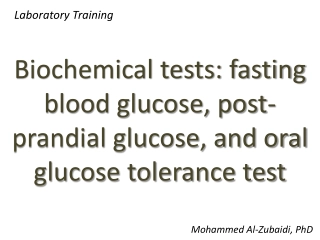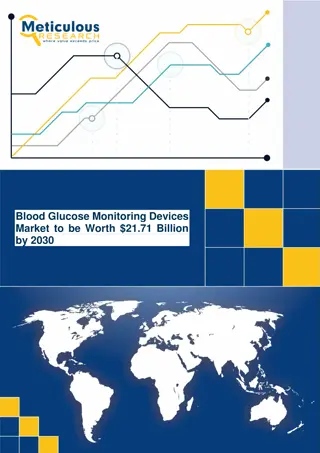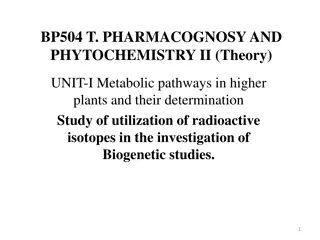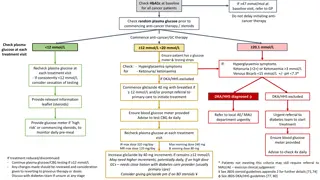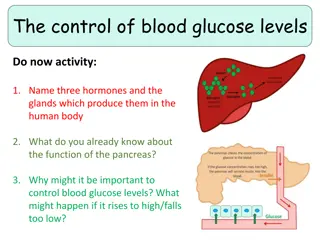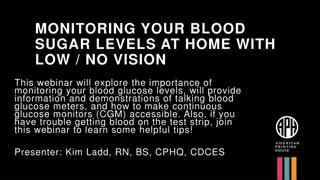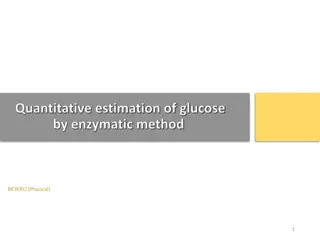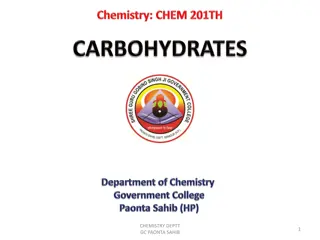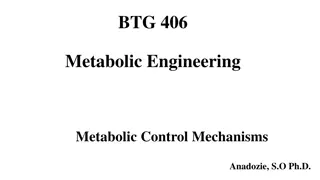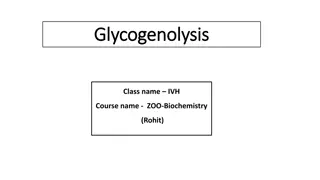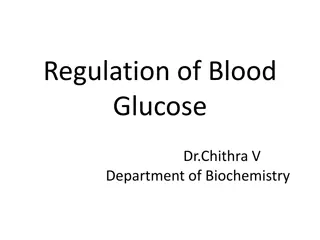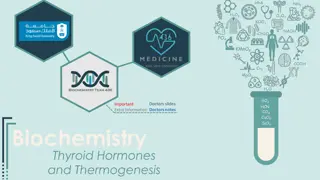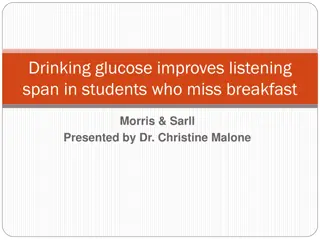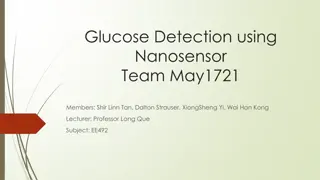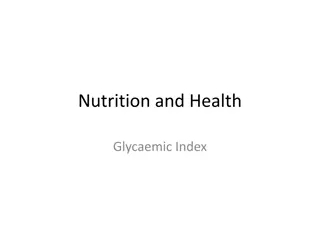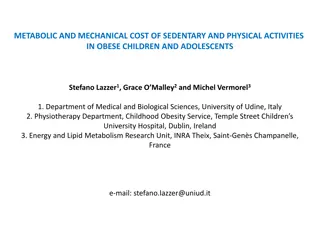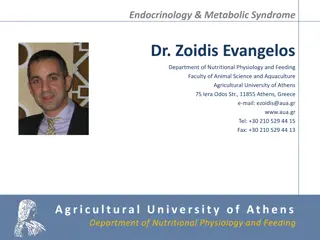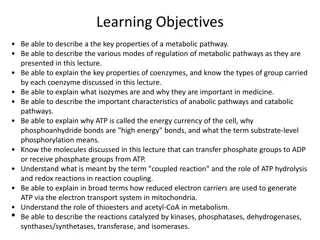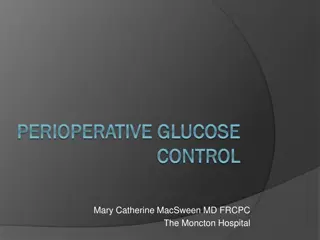
Glucose Metabolic Pathways Overview
Learn about the major metabolic pathways of glucose, including glycogenolysis, gluconeogenesis, glycolysis, and more. Understand the production, utilization, catabolic, and anabolic cycles involved in glucose metabolism. Explore hexose monophosphate pathway (HMP) and glucose transport mechanisms.
Download Presentation

Please find below an Image/Link to download the presentation.
The content on the website is provided AS IS for your information and personal use only. It may not be sold, licensed, or shared on other websites without obtaining consent from the author. If you encounter any issues during the download, it is possible that the publisher has removed the file from their server.
You are allowed to download the files provided on this website for personal or commercial use, subject to the condition that they are used lawfully. All files are the property of their respective owners.
The content on the website is provided AS IS for your information and personal use only. It may not be sold, licensed, or shared on other websites without obtaining consent from the author.
E N D
Presentation Transcript
Major Metabolic Pathways of Glucose By Reem M. Sallam, MD,PhD. Clinical Chemistry Unit, PathologyDept. College of Medicine, KSU
Objectives: Major MetabolicPathways By the end of the first half of the lecture, students are expected to: Define a metabolic pathway. Define reactions, and rate limiting steps in apathway Determine different regulatory mechanismsfor metabolic pathways Describe the general metabolic pathways forglucose (production and utilization) briefly describe the glycogen metabolic pathwayand HMP Recognize the mechanisms of glucosetransport
MetabolicPathway Definition Site: Cellular (tissue) andSubcellular Reactions Rate-limiting enzyme(s) Regulatory mechanism(s): Rapid, short-term Slow, long-term Covalent modification Allosteric Induction/repression
Metabolic Pathways of Glucose: Production andUtilization Glycogenolysis Hexose interconversion Gluconeogenesis Production Glucose Utilization Glycolysis HMP/PPP Hexose interconversion Glycogenesis Krebs cycle
Metabolic Pathways of Glucose: Catabolic andAnabolic Catabolic cycles Glycolysis(Mainly) Krebs (Mainly) Glycogenolysis HMP Anabolic cycles Gluconeogenesis Glycogenesis
Glycogenesis andGlycogenolysis Glycogenesis: Synthesis of glycogen from glucose Mainly liver and muscle,Cytosol Glycogenolysis Degradation of glycogen into glucose Mainly liver and muscle, Cytosol
Hexose Monophosphate Pathway (HMP) or Pentose Phosphate Pathway(PPP) 1- Important source for NADPH Which is used in reductivesyntheses 2- Source for metabolically active ribose Which is used for production of nucleotides: For nucleic acids For co-enzymes
GlucoseTransport Na+-Monosaccharide Cotransporter: Against concentration gradient Energy dependent Carrier-mediated Coupled to Na+transport Small intestine, renal tubules & choroid plexus Na+-Independent Facilitated Diffusion: Down the concentration gradient Energy Independent Glucose Transporters (GLUT1-14)
Glucose Transport: FacilitatedDiffusion
GlucoseTransporters Tissue-specific expression pattern GLUT-1 GLUT-2 GLUT-3 GLUT-4 RBCs and brain Liver, kidney & pancreas Neurons Adipose tissue & skeletal muscle Small intestine & testes Liver(ER-membrane) GLUT-5 GLUT-7 Functions: GLUT-1, 3 & 4 GLUT-2 GLUT-5 Glucose uptake from blood Blood & cells (eitherdirection) Fructose transport
Objectives:Glycolysis By the end of the second half of the lecture, students are expected to: Recognize glycolysis as the major oxidativepathway of glucose List the main reactions of glycolyticpathway Discuss the rate-limiting enzymes/Regulation Assess the ATP production(aerobic/anaerobic) Define pyruvate kinase deficiency hemolyticanemia
Glycolysis: An Overview Glycolysis, the major pathway for glucoseoxidation, occurs in the cytosol of allcells. It is unique, in that it can function eitheraerobically or anaerobically, depending on the availability of oxygen and intact mitochondria. It allows tissues to survive in presence or absenceof oxygen, e.g., skeletalmuscle. RBCs, which lack mitochondria, are completelyreliant on glucose as their metabolic fuel, and metabolizes it by anaerobicglycolysis.
Glycolysis: An Overview Glycolysis, the major pathway for glucoseoxidation, occurs in the cytosol of allcells. It is unique, in that it can function eitheraerobically or anaerobically, depending on the availability of oxygen and intact mitochondria. It allows tissues to survive in presence or absenceof oxygen, e.g., skeletalmuscle. RBCs, which lack mitochondria, are completelyreliant on glucose as their metabolic fuel, and metabolizes it by anaerobicglycolysis.
AerobicGlycolysis-1 Hexokinase Glucokinase
2 2 Aerobic Glycolysis: 6-10 2 2 2 2
AerobicGlycolysis-1 Hexokinase: Most tissues Hexokinase Glucokinase Glucokinase: Hepatocytes
2 Glyceraldehyde 3-Phosphate Dehydrogenase 2 2 For each NADH, 3 ATPwill be produced by ETC in the mitochondria i.e., 6 ATP areproduced 2 2 2
2 2 Substrate- Level Phosphorylation Phospho- glycerateKinase 2 2 2 2
2 2 2 2 Substrate- Level Phosphorylation 2 PyruvateKinase 2
2 2 2 2 2 PyruvateKinase 2
Substrate-level phosphorylationVs. Oxidativephosphorylation Phosphorylation is the metabolic reaction of introducing a phosphate group into an organic molecule. Oxidative phosphorylation: The formation of high-energy phosphate bonds by phosphorylation of ADP to ATP coupled to the transfer of electrons from reduced coenzymes to molecular oxygen via the electron transport chain (ETC); it occurs in the mitochondria. Substrate-level phosphorylation: The formation of high- energy phosphate bonds by phosphorylation of ADP to ATP (or GDP to GTP) coupled to cleavage of a high-energy metabolic intermediate (substrate). It may occur in cytosol ormitochondria
Substrate-level phosphorylationVs. Oxidativephosphorylation Phosphorylation is the metabolic reaction of introducing a phosphate group into an organic molecule. Oxidative phosphorylation: The formation of high-energy phosphate bonds by phosphorylation of ADP to ATP coupled to the transfer of electrons from reduced coenzymes to molecular oxygen via the electron transport chain (ETC); it occurs in the mitochondria. Substrate-level phosphorylation: The formation of high- energy phosphate bonds by phosphorylation of ADP to ATP (or GDP to GTP) coupled to cleavage of a high-energy metabolic intermediate (substrate). It may occur in cytosol ormitochondria
Pyruvate Kinase CovalentModification
Pyruvate KinaseDeficiency HemolyticAnemia
Summary: Regulation ofGlycolysis Regulatory Enzymes (Irreversible reactions): Glucokinase/hexokinase PFK-1 Pyruvate kinase Regulatory Mechanisms: Rapid, short-term: Allosteric Covalent modifications Slow, long-term: Induction/repression Apply the above mechanisms for each enzyme where applicable
Aerobic Glycolysis: ATPProduction ATPConsumed: 2 ATP ATPProduced: Substrate-level 2 X 2 = 2 X 3 = 4 6 10 ATP ATP ATP Oxidative-level Total Net: 10 2 = 8 ATP
Take HomeMessage Glycolysis is the major oxidative pathway for glucose Glycolysis is employed by all tissues Glycolysis is a tightly-regulated pathway PFK-1 is the rate-limiting regulatory enzyme
Take HomeMessage Glycolysis is mainly a catabolic pathway for ATP production, But it has some anabolic features (amphibolic) Pyruvate kinase deficiency in RBCs results in hemolytic anemia

